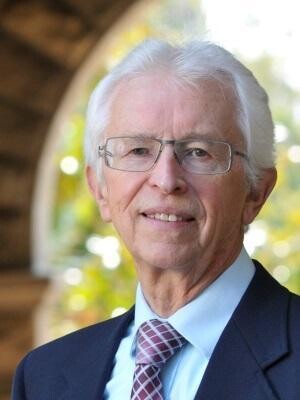hankyoreh
Links to other country sites 다른 나라 사이트 링크
World-renowned nuclear physicist asserts stepwise denuclearization could take as long as 15 years

Stanford University professor and world-renowned nuclear physicist Siegfried Hecker asserted that a stepwise denuclearization process was the “solution” for North Korea, indicating that the denuclearization could take as long as 15 years to complete.
Coming amid the Donald Trump administration’s calls for North Korea to carry out “complete, verifiable, and irreversible dismantlement” (CVID) as swiftly as possible, the argument from one of the field’s top authorities suggests that would be unrealistic. A former director of the Los Alamos National Laboratory, Hecker personally viewed North Korea’s uranium enrichment facilities during four visits between 2004 and 2010.
On May 28, Hecker published a report titled “A technically-informed roadmap for North Korea’s denuclearization,” written with Center for International Security and Cooperation (CISAC) colleagues Robert Carlin and Elliot Serbin, on the university’s web page. Carlin is a former Central Intelligence Agency (CIA) North Korean intelligence analyst and Korean Peninsula expert who co-authored “The Two Koreas” with Don Oberdorfer.
In the report, Hecker’s team argued it would be “unimaginable” for North Korean leader Kim Jong-un to agree to the “Libya model” demanded by the US, which is calling for swift and complete denuclearization.
“Libya never got close to nuclear weapons. North Korea has a threatening nuclear arsenal and a huge complex,” the report noted.
“The suggestion of shipping the North’s nuclear weapons out of the country is naïve and dangerous,” it added.

The research team identified eight areas and 22 specific activities related to North Korea’s nuclear program, including categories of “nuclear weapons,” “nuclear tests,” “missile tests,” “plutonium,” “uranium enrichment,” and “no export.” The report suggested a three-stage “risk management roadmap” over a period of 10 years.
The first stage, lasting one year, would involve a “halt” to military, industrial, and individual activities. The four-year second stage would involve a “roll back” of nuclear complexes, infrastructure, and weapons, with factories and programs eliminated in the five-year “eliminate” third stage. More specifically, the first stage would consist of halting nuclear weapon production, nuclear and missile testing, 5MW reactor operation and the declaration of a halt to nuclear and missile technology exportation.
As a second stage, Hecker called for rolling back weapons, dismantling the 5MW reactor, and joining the Missile Technology Control Regime (MTCR). The final stage would involve the elimination of nuclear weapons and verification thereof, a ban on nuclear testing (joining the Comprehensive Nuclear-Test-Ban Treaty), destroying missiles and banning further development, elimination of uranium and plutonium, and rejoining the Nuclear Non-Proliferation Treaty (NPT).
“Political development will, of course, determine whether or not that time frame can be shortened or lengthened,” the report said.
In a May 27 interview with the New York Times shortly before the report’s publication, Hecker said he personally estimated North Korea’s denuclearization would take 15 years in view of the potential political and technical uncertainties the US and North Korea would face.
“We’re talking about dozens of sites, hundreds of buildings, and thousands of people [employed in nuclear program-related duties],” he said, adding that it would take a decade or more to decontaminate and decommission a single plant handling radioactive materials.
In the report, Hecker noted that peaceful space access and civilian nuclear programs for electricity and medical-related isotope production were “of great importance to the North.”
“We [. . .] suggest that the best verification measures will result from cooperative civilian nuclear programs and space programs [between North and South Korea and the US],” the report said.
By Hwang Joon-bum, staff reporter
Please direct comments or questions to [english@hani.co.kr]

Editorial・opinion
![[Editorial] Does Yoon think the Korean public is wrong? [Editorial] Does Yoon think the Korean public is wrong?](https://flexible.img.hani.co.kr/flexible/normal/500/300/imgdb/original/2024/0417/8517133419684774.jpg) [Editorial] Does Yoon think the Korean public is wrong?
[Editorial] Does Yoon think the Korean public is wrong?![[Editorial] As it bolsters its alliance with US, Japan must be accountable for past [Editorial] As it bolsters its alliance with US, Japan must be accountable for past](https://flexible.img.hani.co.kr/flexible/normal/500/300/imgdb/original/2024/0417/6817133413968321.jpg) [Editorial] As it bolsters its alliance with US, Japan must be accountable for past
[Editorial] As it bolsters its alliance with US, Japan must be accountable for past- [Guest essay] Amending the Constitution is Yoon’s key to leaving office in public’s good graces
- [Editorial] 10 years on, lessons of Sewol tragedy must never be forgotten
- [Column] A death blow to Korea’s prosecutor politics
- [Correspondent’s column] The US and the end of Japanese pacifism
- [Guest essay] How Korea turned its trainee doctors into monsters
- [Guest essay] As someone who helped forge Seoul-Moscow ties, their status today troubles me
- [Editorial] Koreans sent a loud and clear message to Yoon
- [Column] In Korea’s midterm elections, it’s time for accountability
Most viewed articles
- 1[Column] The clock is ticking for Korea’s first lady
- 2Samsung barricades office as unionized workers strike for better conditions
- 3[Editorial] When the choice is kids or career, Korea will never overcome birth rate woes
- 4S. Korea, Japan reaffirm commitment to strengthening trilateral ties with US
- 5[News analysis] After elections, prosecutorial reform will likely make legislative agenda
- 6Japan officially says compensation of Korean forced laborers isn’t its responsibility
- 7Why Israel isn’t hitting Iran with immediate retaliation
- 8[Editorial] As it bolsters its alliance with US, Japan must be accountable for past
- 9[Editorial] Does Yoon think the Korean public is wrong?
- 10[Guest essay] How Korea turned its trainee doctors into monsters